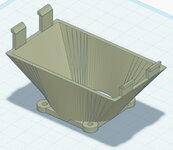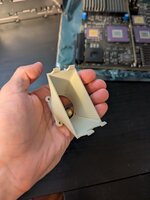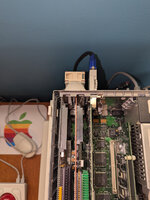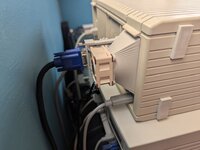I don't know how useful this'll be for others since it's a pretty specific use-case, but I have a couple extra toasty full-length cards in my IIci, and I was trying to come up with a way to get some air moving through that walled-off part of the case. Since these particular cards don't require mounting brackets, I removed them and came up with this little snap-on duct thing for a 40mm fan that spans two adjacent NuBus slots:




It's not perfect, but what I found neat is that this model was almost entirely generated by ChatGPT 5. I took some measurements, and then told it roughly what I wanted and gave it the measurements, and it spit out a downloadable STL (along with some configurable Python code to create that STL). It took a couple back-and-forths and some minor manual tweaks to arrive at the final model. I particularly had to help it with the snap-on mounting tabs, but everything else is completely LLM-generated. One tiny step closer to a Star Trek replicator
It does seem to work pretty well too. A sheet of paper is now pulled against the vents at the front and top of the case, so I know fresh air is now being drawn in to that area of the case and spit out the back. The fan wires can be tucked under the duct and routed into the case, or the fan can just be powered externally.




It's not perfect, but what I found neat is that this model was almost entirely generated by ChatGPT 5. I took some measurements, and then told it roughly what I wanted and gave it the measurements, and it spit out a downloadable STL (along with some configurable Python code to create that STL). It took a couple back-and-forths and some minor manual tweaks to arrive at the final model. I particularly had to help it with the snap-on mounting tabs, but everything else is completely LLM-generated. One tiny step closer to a Star Trek replicator
It does seem to work pretty well too. A sheet of paper is now pulled against the vents at the front and top of the case, so I know fresh air is now being drawn in to that area of the case and spit out the back. The fan wires can be tucked under the duct and routed into the case, or the fan can just be powered externally.
Attachments
Last edited:
